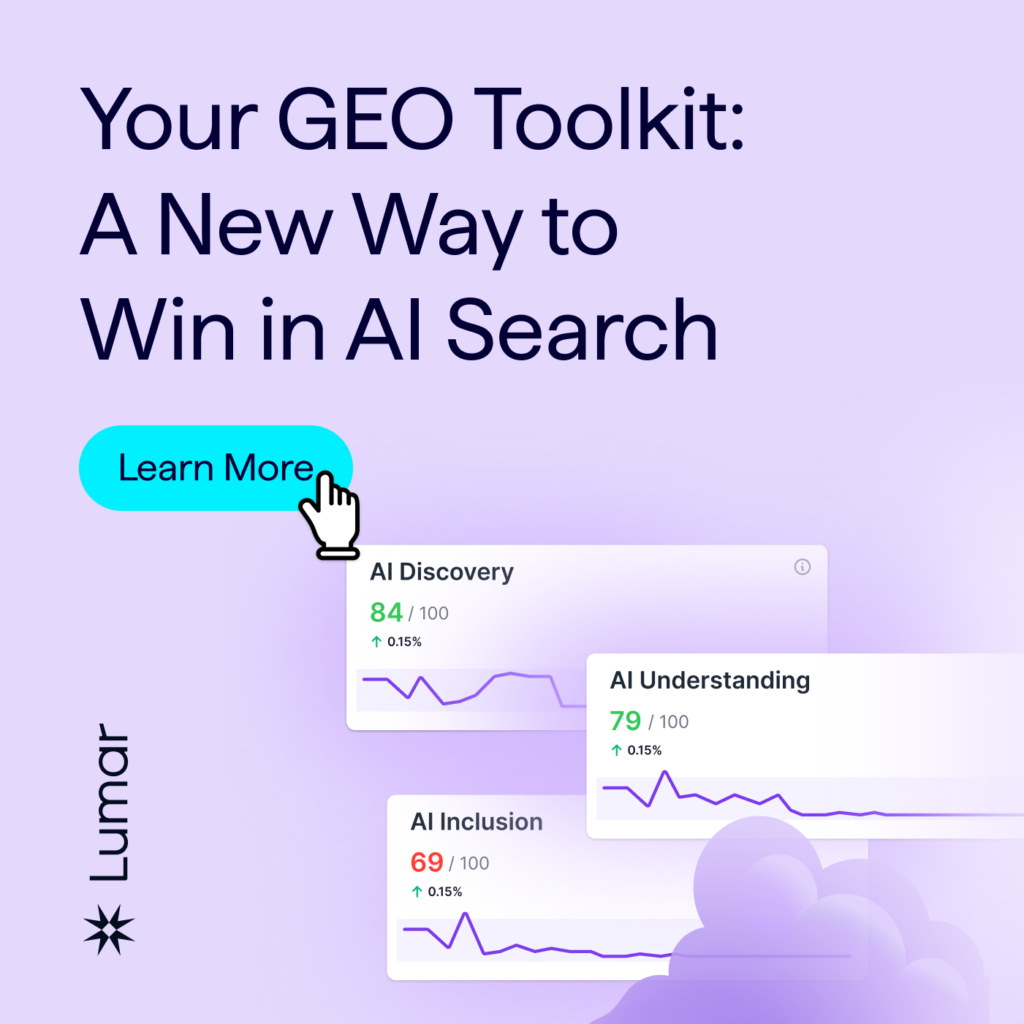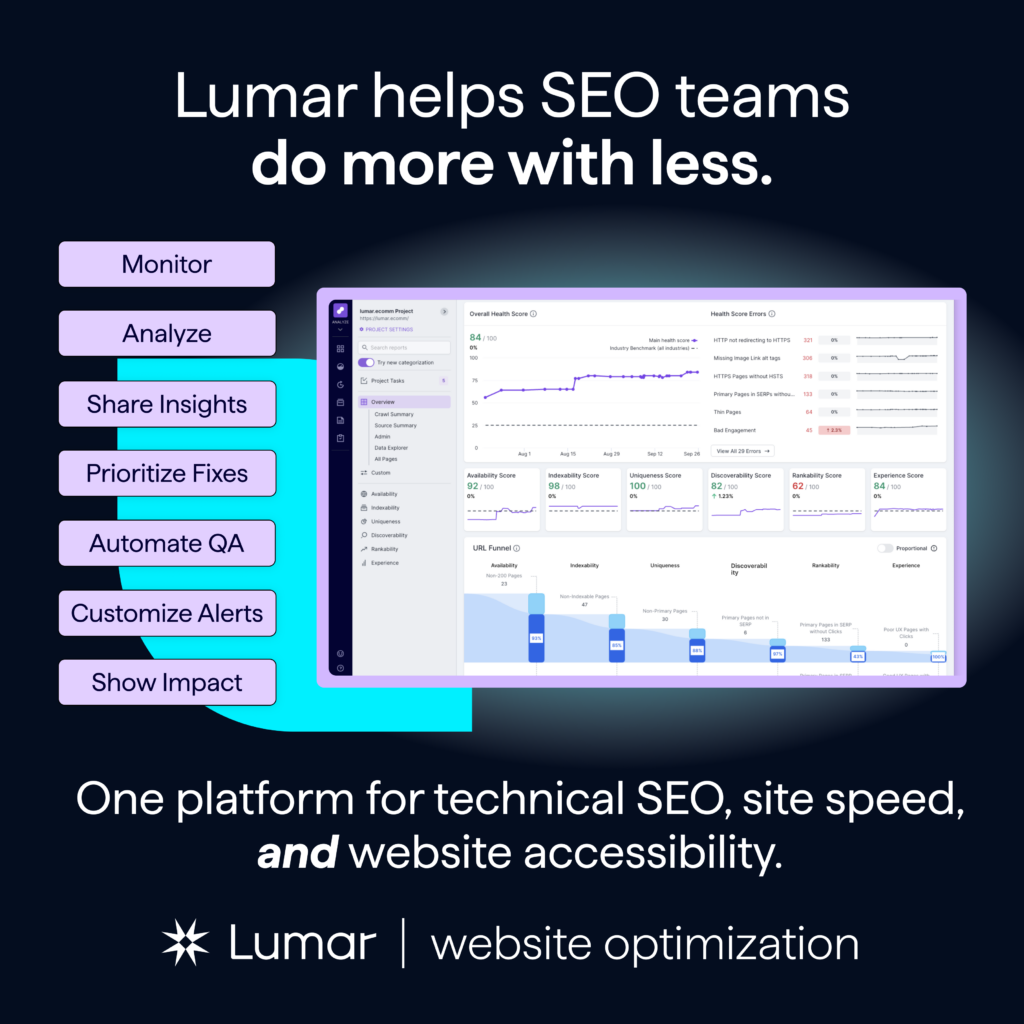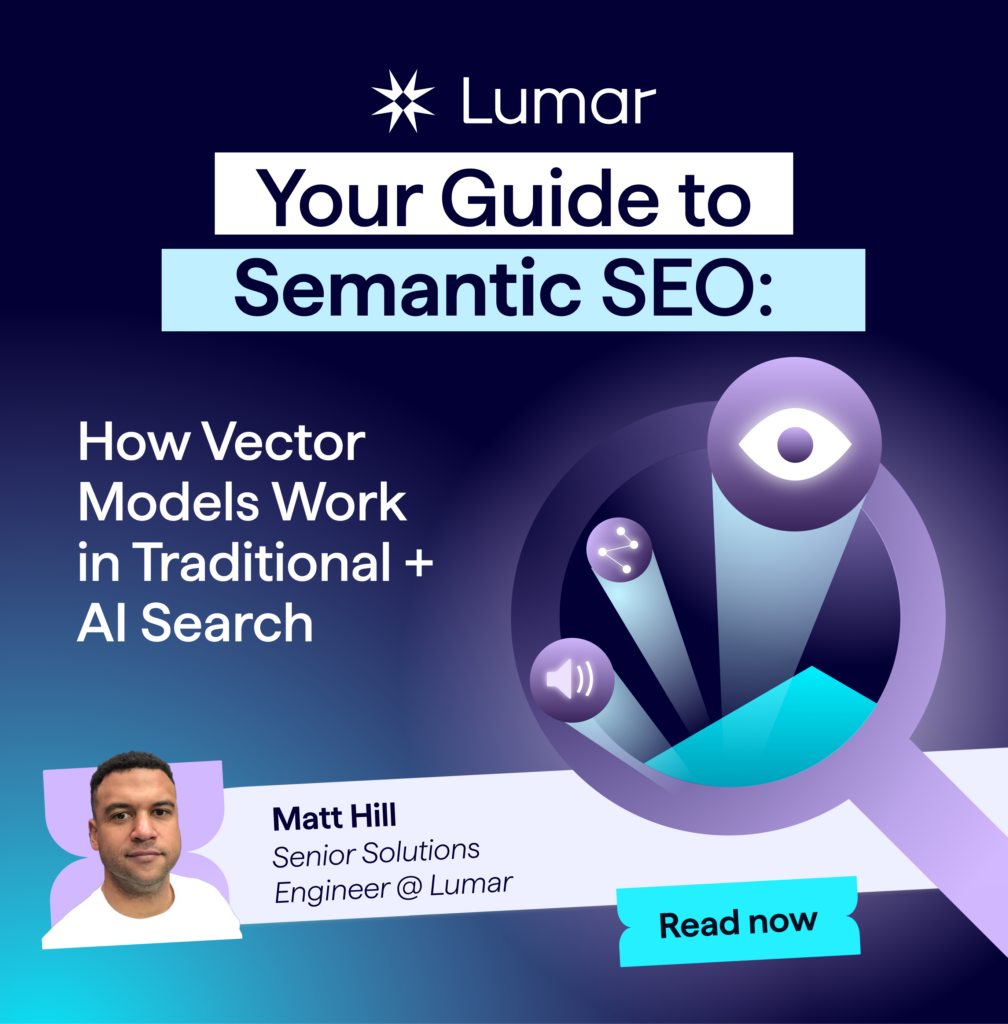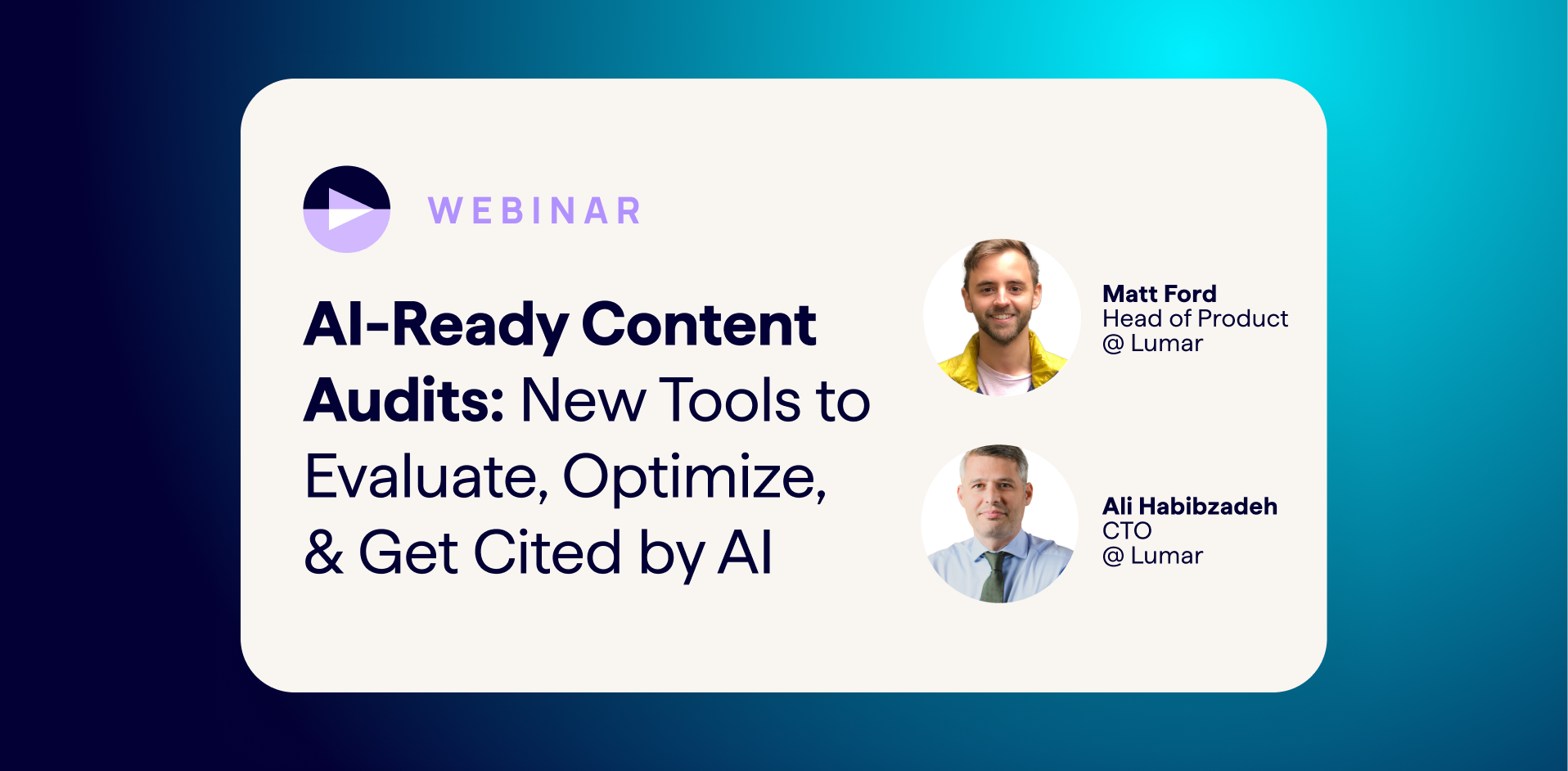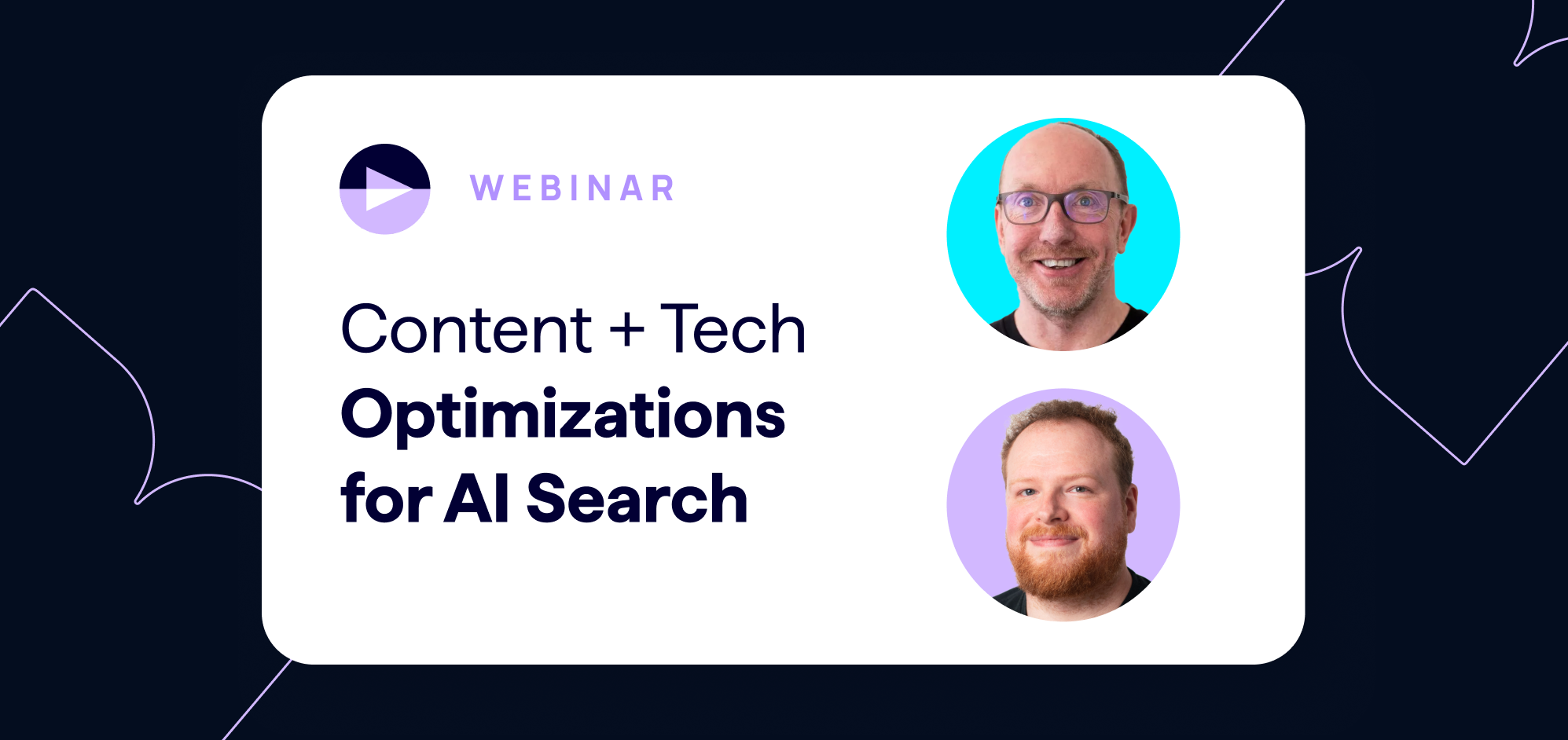From SEO to GEO (generative engine optimization)
AI, large language models (LLMs), and semantic search are changing how users find information online — and how SEO works today.
Search experts Kevin Indig, Jamie Indigo, Nelson Sarco, and Matt Hill feature in this all-star SEO panel discussion on AI and the role of semantic relevancy in search today.
Watch the full AI-Ready SEO webinar above – including audience poll results and Q&A session.

Meet the Webinar Speakers
- Kevin Indig, Growth Memo
- Jamie Indigo, Cox Automotive
- Nelson Sarco, Momento AI
- Matt Hill, Lumar
Your SEO & GEO strategy: Adapting to the rise of AI search
How has AI changed the way users search?
AI has made online search more conversational, says Nelson Sarco, CMO at Momento AI.
“Traditionally, you go to Google, you look something up, you get your answer, you click around… Whereas with GPTs, AIs, it’s within one environment. You can ask follow-up questions. It’s really intent-driven,” says Sarco.
“I think the big difference is that it’s changed the mindset of users — they expect direct and fast answers.”
AIs are doing more of the information consolidation that we previously had to do ourselves. And it’s getting better at taking user intent on board.
“With traditional search, again, you’re going through Reddit, you’re going through forums, you’re going through YouTube, trying to consolidate all of this information into one in your brain,” continues Sarco. “Whereas now, within AI platforms, it’s all there. I do feel like, for me personally, it’s a more fun, interactive way of getting information.”
Growth Memo’s Kevin Indig agreed, adding that the SEO space has been “relatively stale” for the past five years, and the current AI-instigated “shakeup and rumble” in the industry represents a huge opportunity for SEO professionals.
“I’m just excited for things to change, for us to find new ways of working over time, for users to find new ways of engaging, and for all of that to open space and opportunities [in SEO], and it’s not like the same thing day in and day out.”
Jamie Indigo, Director of Technical SEO at Cox Automotive, brought a healthy dose of skepticism to the conversation, cautioning that the “verification portion has been swept under the rug.” The accuracy of AI-generated information doesn’t always stand up to scrutiny, which can lead to misinformation issues.
“I think Nelson hit it big when he said you used to search and verify information — that verification portion has been swept under the rug in the confetti and flowers of AI interactions.”
“Look, I can get everything all at once, but the accuracy of the information presented doesn’t quite fall under the same scrutiny.”
Is it time to reset search KPIs and leadership’s expectations of SEO?
With AI changing the SERPs and user behaviour, is it time to rethink your SEO KPIs and reset expectations with leadership?
“I think it is a great opportunity to rethink metrics and KPIs — and I also think that it takes some judgement and carefulness to find the right degree between saying, ‘look, here’s how we should adapt’ and saying, ‘you know, this is what still remains the same.’,” says Indig.
“Because the reality is, Google is still there. Google’s still strong — everybody still uses Google. That’s not going away in a sense. I’ve done some research on that… People still use the classic organic results — for example, for validation in some cases.”
“And so I think the art here is to find that degree where you show leadership what the future could look like, how to adapt to this environment, and yet at the same time don’t discredit all the stuff that still does work and still does bring results. I’m having that conversation with all of my clients, all of them, 100%, right now.”
“What is true is that we are seeing certain metrics becoming less useful. Like clicks, for example. And at the same time clicks have always been a means to an end — and that end is conversion, or helping users find what they’re looking for. It’s never just been about more traffic.”
Nelson Sarco advised SEOs to “hit the brakes a little bit” and not to buy into the fear of missing out (FOMO). Instead of rushing to implement every new AI-focused SEO tactic, teams should first analyze whether or how AI is impacting their bottom line right now and how customers are currently finding them.
A key takeaway from this part of the conversation was the importance of grounding your strategy in facts. Since AI models are still just bots that need to crawl content, SEOs should prioritize technical foundations.
“Fundamentally, these are still bots. Bots still need to crawl,” says Jamie Indigo. “Ground [your AI SEO strategies] in facts. If you can’t prove that it does what it says it does, be skeptical.”
This means paying close attention to log file analysis, crawl behavior, and what content is available without client-side rendering, as some AI crawlers are still reluctant to execute JavaScript.
Risks and misconceptions around AI search and GEO (generative engine optimization)
Jamie Indigo highlights that nothing AI says is ever true; it’s just statistically probable.
“What’s happening here is very similar to the 1999 fad toy, the Furby,” explains Indigo, “The Furby was a cute little furry monstrosity that came knowing 50 words and then learned 10 more from hearing you talk.”
Indigo explained that AI models, much like a Furby, are simply learning patterns and repeating them. They lack a concept of objective truth, instead providing only what is statistically probable, which allows AI to easily repeat propaganda and harmful information.
“So there needs to be that skepticism and that grounding balance into how we interact and treat these things,” Indigo says.
Sarco reminds us that results are based on historical user habits, too. This makes it especially difficult to objectively gauge where your brand is ‘ranking’ in terms of inclusion in AI responses.
“A lot of AI platforms are using users’ historical information to serve them what they feel will be best for that user,” he says.
“You may be showing up for a specific brand for one particular user, but not for the other,” he says. “That’s the other problem with tools, they’re giving you a ‘rank’ within these GPTs, but it’s not consistent.”
Another pitfall, according to Kevin Indig, is that the value of appearing in AI search is not yet fully proven.
“What’s the value of being cited or mentioned in an LLM like ChatGPT?” Indig asks. “We don’t know that exactly yet. We see a small amount of referral traffic coming to our sites. That traffic is growing. And it’s converting at much higher rates compared to Google traffic.”
“However, that’s the aggregate effect of what we’re seeing right now. A lot of that could be driven by the growth of ChatGPT itself. But we don’t yet know exactly what’s the incremental benefit or value of investing X more dollars into, say, content, so that we’re more visible in LLMs. Similar to AI Overviews, it’s not yet proven out. … It’s very hard to measure.”
The value of appearing in AI responses is especially hard to gauge in industries like publishing, where revenue may be based on metrics such as on-site ad impressions or affiliate links.
“It’s still a bit of a TBD, right?” says Indig, “So it comes back to that point of walking the line between riding the hype a bit and kind of using that for good, and, on the other side, being careful and critical, like ‘is that worth it?’ Or will we in a year get to a point where we say, ‘we don’t give our content away anymore for free, you need to pay — say, through ‘pay per crawl’ through Cloudflare — because the value [of giving it away for free] is just not there.”
“Yes, this is breaking the model of the internet,” says Jamie Indigo, “If Google’s suddenly gone from being the platform to the publisher as well… what boon is there to your business? How will that impact it?”
Regarding the question of whether to optimize for “meaning, not keywords,” the panel’s answer was nuanced. While the idea is not entirely new, it’s a good opportunity to move toward a more sophisticated, technical approach. Kevin Indig suggested that SEOs could move from spreadsheets to vector databases, crawling their sites more often and systematically looking for gaps in topic coverage.
GEO and semantic search strategies
“Time is a flat circle,” says Indigo, “We’ve absolutely been down the semantic optimization rabbit hole. Here’s the deal: if you’re doing vector embedding optimizations, you’re turning an article into math to figure out what keywords to stuff back into it. There’s something to be said for fully answering an intent and truly understanding it, but nuance is important here.”
Semantic search, of course, isn’t new — search engines have been relying on vector embedding technology to improve their search results for years. Many SEOs have come across this concept before.
“A lot of these things that are now bubbling up again — we’ve been there before,” agrees Indig, “It’s maybe a good opportunity to hopefully make that shift for good.”
“I think part of what’s missing here is a very clear playbook that shows people how to switch to a more semantic approach or how to use embeddings or start at emeddings and think more about topic and intent than keywords.”
“But when I talk to 10 different people, I get 15 different approaches for how to do this. I think what’s missing is for more people to share their approach and how it has worked for them — and to make it very tangible what the difference is between ‘topics’ and keywords.”
“I think this whole content optimization topic… becomes more technical. We should approach it more technically. We should crawl and embed our site more often and then it’s like, systematically looking for gaps in our topic coverage. So, zooming back in on an article to say, ‘okay, does this article cover all the topics that are important?’ — Or, scaling back, ‘how many articles have severe gaps in the topics that they target?’ And then how can we systematically fill these gaps, maybe with better content briefs, maybe with AI drafts, maybe with something else. But I do think that there are some new ways of doing things.”
Key takeaways for future-proofing your SEO strategy for AI
To conclude the webinar, the panelists offered some actionable tips for SEOs preparing for the era of AI search:
- Talk to your customers. Have a program where you regularly talk to your customers to understand their pain points and how they search for information. This will provide a solid foundation for your prompt strategy and topics to cover in depth.
- Establish basic monitoring. Set up monitoring for log files, referral traffic from LLMs, and AI visibility. This will help you understand where you currently stand and identify technical issues that might be preventing your content from being seen by AI crawlers.
- Experiment and stay agile. Test new strategies and tactics, but be cautious and critical of the results. As Nelson Sarco said, “Don’t panic…keep learning.” The playbook is still being written, so staying informed and agile is essential.
Jamie Indigo added a final, important note: “Ground [what you’re doing for AI SEO / GEO] in facts because what we have right here is a ton of FOMO.” By focusing on what you can control—your technical SEO foundation, your data, and your testing—you can build a resilient strategy that will weather whatever changes the future of search brings.
Don’t miss the next Lumar webinar!
Sign up for our newsletter below to be alerted about upcoming webinars, or give us a follow on LinkedIn to stay up-to-date with all the latest news in SEO, GEO, and digital optimization.
Want even more SEO insights on-demand? Browse Lumar’s full library of SEO and website optimization webinars here.
